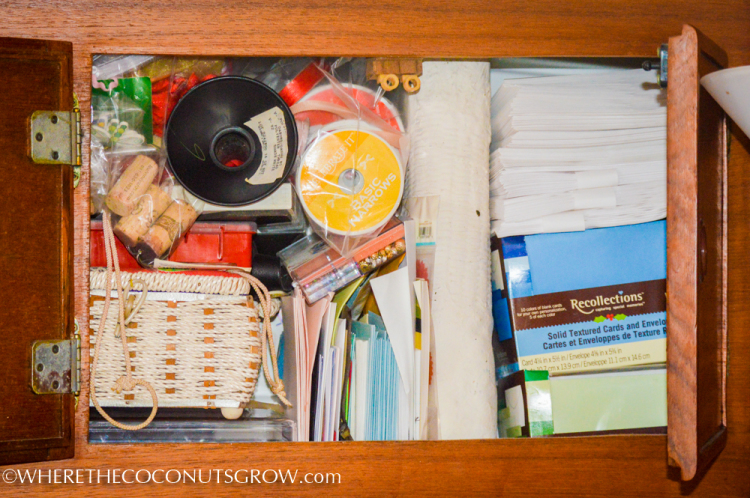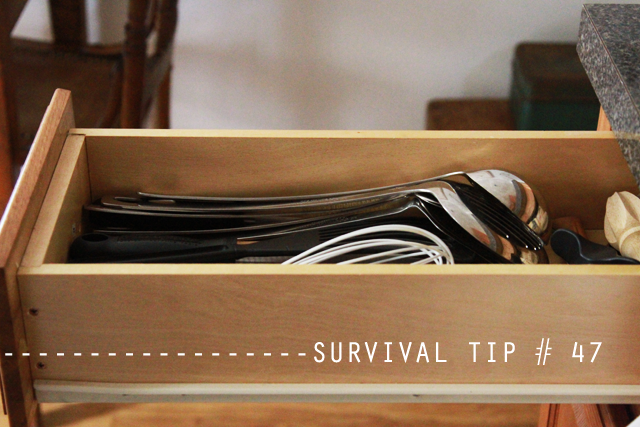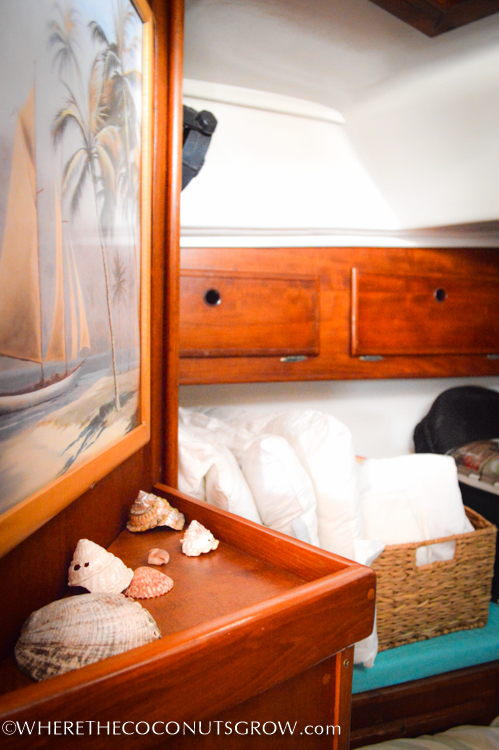A shelf in the garage, a junk drawer, a desk covered in papers, a stack of magazines, a box of old photos…
Throughout life we tend to collect belongings without thinking about why we are keeping them. We buy things we once needed or wanted and we receive gifts from loved ones and friends. Sometimes we look around our home and think, “where did it all come from?”
I remember when I was a little girl, I would always peek inside one particular drawer in a black antique chest that my grandparents owned. Inside that drawer was a black plastic organizing tray and a small woven basket. Every evening my grandfather would empty the change in his pockets into that basket. He told me I could have whatever he put in there and that it was our little secret. My grandmother knew about it the whole time but I still smiled every time I reached my little hand in that drawer because it was ‘our secret.’ Even as an adult, I would still casually open that drawer every time I walked by just to see if he left me anything special!
My grandparents have relocated many times. Each time they moved, the contents of that drawer never changed. Whichever house they were in, that drawer was always in the same place and that basket was always in the same spot. A few years ago I finally shouted, “these things have been in this drawer for years!” Then, I took everything out and put something else in there instead. Just like that. My grandmother is still working on getting rid of 50 years worth of STUFF!
Only you will know when you’re ready for change. And when you are, I hope these Helpful Tips for Downsizing will make the process a little less intimidating.
PART 2: MAKE A DECISION
In PART 1 you learned to START EARLY before you actually need to downsize. If possible, don’t wait until you’re forced to make decisions about keeping or getting rid of your things. You also learned some helpful tips to keep in mind while you REDISCOVER your belongings.
As you sort through everything, make a decision on how you feel about every item in your house. I like to start new piles to help me remember the decisions I make:
- GET RID OF IT – It can no longer exist in your space. It needs to go away or change form.
- DECIDE LATER – If you’re not ready to make a decision, put it in this pile until you are.
- KEEP IT – It’s important and you’re not willing to get rid of it.
TAKE AN HONEST LOOK AT YOUR MOTIVES
If you have analyzed your motives honestly, there is no good or bad decision. Whatever you choose, it will be the right one for you. Here are some questions to ask yourself when making your three piles:
- Does it invoke a feeling of JOY for me?
- Does it invoke a feeling of JOY for someone else?
- Is it important to me?
- Is it important to someone else?
- Is it mine?
- Was it a gift?
- Do I need it?
- Will I need it someday?
- How many do I really need?
- How likely is it that I’ll need a spare?
- If I do need to replace it, how easy will it be to replace?
- Is it one-of-a-kind?
- Is it functional?
- Is it useful?
- Does it have multiple functions?
- How much did it cost?
- How much is it worth?
- Can I return it?
- Is the cost of storing it greater than the cost of replacing it?
- Does it bring up bad memories?
- Have I used or worn it in the last year?
- If I continue to store it, how long will it last?
- Do I have room to store it?
- Can I make it fit in the space I have?
- Does keeping it make sense, considering my own personal reality and circumstances?
- Is it contaminated?
- Is it worn out?
- Is it repairable?
- Can I still wear it?
- Is it out of style?
- If I didn’t already have it, would I buy it?
- No idea why I still have it?
By this point, you have probably emptied the contents of a drawer or a box or a closet into the center of your living room. Maybe you have piles started all around your house.
If this process doesn’t scare you, don’t draw it out any longer than it needs to be. Go ahead and get busy making decisions. For a lot of people it’s not easy to make a decision, which is why they end up with years-worth of clutter. Remember to only do as much as you are comfortable with and don’t let anyone tell you otherwise.

STILL HAVING TROUBLE?
Here are a few examples…
- Clothes: A year ago I moved onto a boat and my long term plans involve living in the tropics. I got rid of most of my cold weather clothes and stored the items that I really love and might want to wear again someday. I got rid of most of my office attire since it is highly unlikely I’ll need it within the next 5-10 years. I kept expensive items that aren’t worth replacing and stored those as well. I brought with me more than 10 bathing suits, 8 pairs of flip flops (almost all of which have broken due to the harsh marine environment), one pair of running shoes and a small pile of other lightweight items. Clothes, shoes and accessories are things that require consideration of the future. Are you ever really going to wear it again? Do you really need 40 pairs of shoes, 35 hats and 20 ties? If having that big of a selection brings you joy, then by all means… keep them!!
- Coffee Mugs: Most people only use one mug per day if they are a coffee or tea drinker. Most people also clean their dishes every day or every other day. If there’s a chance you might go 10 days without doing dishes, you might actually need 10 mugs! If there are two people in your household, you’ll need double that. Another thing to consider is favorites. I used to collect ‘favorite’ mugs and I am still particular about which mug I grab every morning. My favorite mug today is not the same one it was 5 years ago, so I know at some point I’ll need to reevaluate the mugs I own. Sometimes they break and I make a new favorite. My boyfriend and I each have two favorite mugs we use (one of which is a to-go style) and we stash a few spares in the cupboard just in case our favorite mugs break or are left behind. I’m sure we’re not the only ones that have left a mug on the top of a car, or on a shelf in a store, or at someone else’s house.
- Kitchen Utensils: Sometimes downsizing can mean choosing between Grandma’s old wooden spoons and the new and improved heat-resistant silicone two-in-one thingamajig. I think Erin says it best in her blog Reading My Tea Leaves about life in a tiny apartment, “I don’t have the space for single-layer spoons, and you might not either.” You don’t have to pick just one, but be realistic about the space you have.

- Books: I hold on to books that hold sentimental value and create feelings of joy. I hold on to books that someday I hope to read to my own children. I hold on to books that I want to share with someone someday. I hold on to books that I might want to reference in the future. I get rid of books that don’t mean anything to me, or that I’ve never read and never plan on reading.
- Magazines: These could be very useful, although they tend to be the #1 item that turns into junk in my home. They stack up so fast and I just stuff them in a corner. Why? Because someday I might want to look through them? Sure, maybe. I try to skim through the ones I know I don’t care to read before getting rid of them and I make a new, smaller pile of the ones I still intend to read.
- Recipes: There are billions of recipes printed in books and on the internet. I don’t even like to cook and I still have too many cookbooks. Someday, I plan on developing an interest in trying new recipes so for me, I’m just not ready to part with them yet. I sort through what I can, getting rid of cookbooks or recipes that don’t look appealing anymore. I delete links I’ve saved in my favorites on the computer if I know I won’t ever visit that recipe again. If I decide to keep recipes, I make a new pile of recipes I’ve already tried and would make again, and another pile for recipes I still want to try. I do my best to remember that it’s okay if I’m not ready to part with them!
- Holiday Decorations: Decorations are often passed down and inherited from family members and loved ones. It’s hard to get rid of something that meant so much to someone else. Only you will know if special decorations are important enough to keep or if you are okay with getting rid of them.
- Collections: Okay, so I have a SMALL collection of seashells. Do they make me happy? YES! Can I find a place for them so they are out of the way? Yep! I’ve got handfuls of them stashed all over the boat! It’s the only collection I have left and I’m okay with that. I definitely don’t have room for any more collections though.

- Crafts: Do I still have an interest in craft projects? Yes. Do I hope to start making cards again in my free time? Yep. Are my supplies valuable enough to occupy space in my tiny home? You bet!
- Pictures: I know I am not willing to get rid of most of the printed photos I have. They are in albums and boxes and it would take me months to go through them all. Someday I’ll take on that project, but not today. It’s important enough to me to store them, whatever the cost.
- Size: If moving to a new space, you’ll also need to consider whether or not you will have room for everything. Take measurements, visualize the new space. I obviously can’t fit a treadmill inside my boat, but I could probably find a spot to store my card making supplies. If it’s important enough, I can make most things fit.
- Application: Will you really need 6 surfboards if you’re moving to Arizona? How often will you use a snow shovel in Southern California? Will I need 13 kinds of cleaning brushes after moving into a tiny studio? It’s important to be realistic about where you see yourself one year from now, or even 5 years from now, and looking at how your circumstances will change.
In the final part of this Helpful Tips for Downsizing series you’ll get a few ideas on how to actually DO SOMETHING with the three new piles you’ve just created!
By Jody Pountain for the [Tiny House Blog]

Thanks for the tips on downsizing….enjoyed reading.
Most welcome, Melissa. Glad you enjoyed it!
I try to keep my 800 square foot house fairly free of clutter and “stuff”. Those are excellent questions to ask when evaluating an item. I am putting that list on my favorites list so the next time I rummage through my closet I can ask those questions!
Thanks Amy! And congrats on the clutter free home 🙂 It’s not always easy!
electronics! Old phone and camera chargers, cords, add-on accessories. Lordy, they are stuffed in every drawer. I’m tackling those next.
Ahh, that’s a good one Susan! I have a bin full of them too. Even if you can get them all in one place, its a great start! Good luck 🙂
Great advice….now I need to apply it!
Thanks Terrie! Let me know how it goes!
Great inspiration! Only exception for me is the cookbooks. I cherish mine as if they were personally autographed copies of a Hemingway novel. They always take me to a kitchen somewhere else on earth and that brings me joy.
Granted they won’t all be traveling with me on my sailboat and I already have most of my favorites in both hardback and kindle versions so they can sail and along with me.
It will be very hard to choose the few that aren’t available on Kindle to take with me, and I may decide to leave them on land for their protection even then.
Well I’ve gone on too long. I need to start paring down now, so thanks for the kick in the butt!
See you on the water,
Sail Away Girl
Sail Away Girl, that’s wonderful 🙂 Sounds like you have a great plan for bringing them along electronically. Make sure to get a good waterproof case for that kindle if you haven’t already.
In the last year I haven’t experienced any damage to my books from the marine environment so don’t be too afraid to bring them.
I’m excited for you to actually take YOUR kitchen to many different places 🙂 Following along and hope to see you soon!
I am constantly downsizing and read everything I can about simplifying life but have never read this perfect question until your post, “If I didn’t already have it, would I buy it?” Brilliant! There are many questions I’ve asked myself but this isn’t one. I believe this will allow my brain to release a hold on another layer of stuff I do not need!
I met a guy on the beach that makes jewelry and we got to talking about sea glass. He says he never finds any. I told him I have buckets full I’d love to share. When he gets around to sending me his mailing address I’m going to mail him some of my growing collection. I didn’t want to toss it and LOVE knowing it will go into art that he will pass on : )
Darris,
That makes me happy! I’m so glad I could help you view the process a different way to get you un-stuck 🙂 Keep me posted on how it works out!
Thank you for sharing your sea glass story. It’s a beautiful example of how everything happens for a reason and now your special collection will bring joy to someone else!! Love it 🙂
That list of questions is so spot on! I really like your practical approach that still leaves room for some emotional attachment.
A couple of things I’ve started doing lately is keeping all the manuals and receipts for tools and appliances in one folder and going through it regularly to see if any belong to things I no longer have. I also label any cords or accessories that belong to electronics with the name of the item and only keep things that belong to stuff that’s staying.
If something doesn’t work it gets labeled right then and there and goes into a “needs repair” box for further action. If it’s not economically repairable it gets recycled appropriately and all it’s little bits and pieces go too, unless they have other uses. No more non-functional flashlights, mystery accessories or broken tools to dig through.
Thanks Alice! Those are great purging practices, and they really do help keep the clutter down. I do the same thing myself 🙂
Very helpful… I liked the attention to the question “Does this item make you happy?” It’s a good reminder that you don’t HAVE to get rid of everything that doesn’t necessarily serve a purpose 🙂
Becca, Absolutely! The biggest misconception most people have is that you HAVE to get rid of things. If you can honestly find a good reason to hold onto an item, fantastic. In my mind, this whole process can help us get rid of all the things that don’t matter, and help us appreciate the things that do matter.
Great reading! One of the most effective approaches I’ve used is to put ‘like with like’ first, not even thinking about the purge yet. It’s astonishing, after you’ve been through every nook & cranny of a space, to see the accumulated pile! Scary even!
At the very least you know where all your markers, or cheese knives, or flower pot saucers are, so you don’t buy another because you can’t find the ones you have!!
My experience is that it’s then much, much easier to toss or donate the bulk of it, putting what you decide to keep in a clearly marked container in a logical location!
It brings a lighter, clearer feeling… And helps position you for whatever’s next ;-))